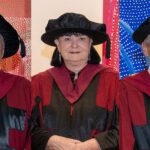The worlds of art and science collide in ‘On Cloud Seven’, a solo exhibition by international artist and Curtin University School of Design and Art lecturer, Dr Ioannis Michaloudis.
The exhibition to be held at the Perth Town Hall between June 6 and 14 showcases Dr Michaloudis’ pioneering work using the space technology nanomaterial silica aerogel, the lightest solid known.
Silica aerogel is used by NASA as a heat insulator for spacecraft and for the collection of ‘stardust’.
Dr Michaloudis is the first artist to introduce the material into the visual arts. Since 2001 he has based numerous research projects on this space technology.
‘On Cloud Seven’ will feature one sculpture, three photos and nineteen wall artworks.
The exhibition will be opened by the Greek Ambassador to Australia, Mr Haris Dafaranos and exhibition curator, Mrs Eva Dafaranos on their official visit to Western Australia.
‘On Cloud Seven’ is a public representation of a broader research concept called Etherospermia: The sky-seeding project, developed with master degree student Luke Aleksandrow and presented to the 64th International Astronautical Congress in Beijing last September.
Through Etherospermia, Dr Michaloudis interacts with scientists to imagine how silica aerogel might be used in the future to create new atmospheres on other planets and make them habitable.
Dr Michaloudis considers silica aerogel to be a personification of our ‘breaking sky’ and his artworks represent a potential scientific response to the destruction of the ozone layer.
“Etherospermia examines the potential use of silica aerogel for the cultural utilization of space. This is based on the concept that humans will in future need to cultivate ‘new skies’ in response to the breaking of our atmosphere’s dome,” Dr Michaloudis said.
“In this era of space exploration, it is clear that humans need to develop new survival skills. It is also clear that science and art need to collaborate more closely. Etherospermia provides a link between imaginability, experiment and representation in both science and art”.
The Etherospermia project pursues the creation of new atmospheres on other planets to draw attention to the degradation and destruction of the earth’s protective veil.
“Imagine an astronaut on a space-walk scattering fragments of silica aerogel into space, and these sky-spores growing into new atmospheres on other planets and making them habitable.
“The artworks are presented as an allegory for how scientists could see the world from an artistic point of view. The art goes beyond science, and the artworks are symbols for generating new ideas and thinking,” Dr Michaloudis said.
The Etherospermia research paper, co-authored by Dr Michael Seats at the Curtin Learning Centre, has been selected for publication in the Acta Astronautica journal, sponsored by the International Academy of Astronautics. It also forms the basis of presentations delivered by Dr Michaloudis at various international astronautical conferences.
Dr Michaloudis said scientists loved the concept. “They are like excited children when they begin to imagine the limitless possibilities of art and science colliding”.
The exhibition is dedicated to the celebration of the 30th anniversary of the sister city relationship between Perth and Kastellorizo, a Greek island of international repute and beauty in the south-east Aegean Sea.



